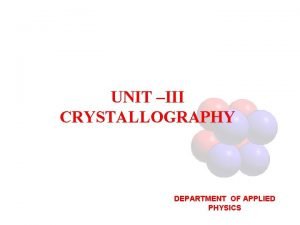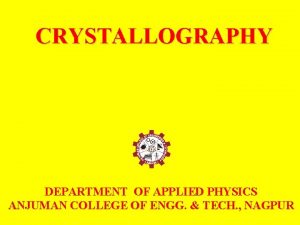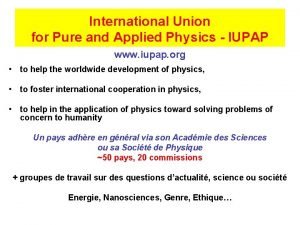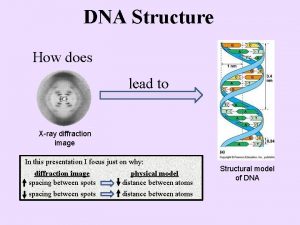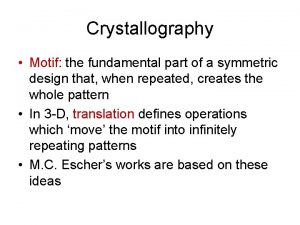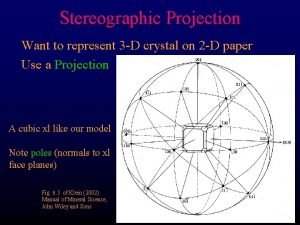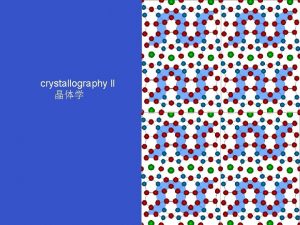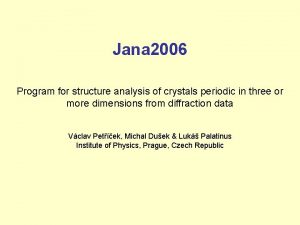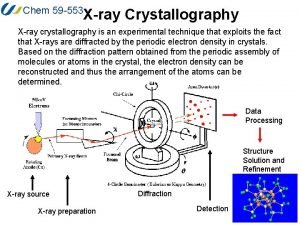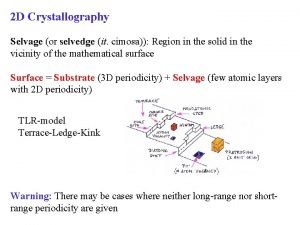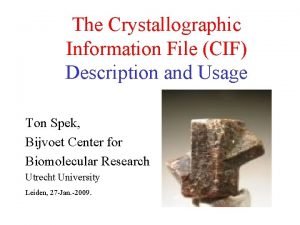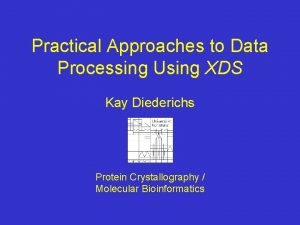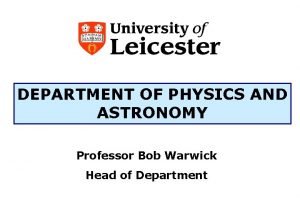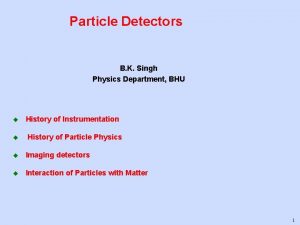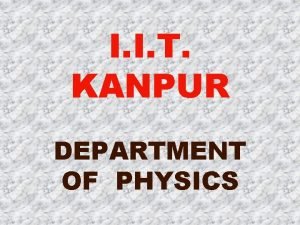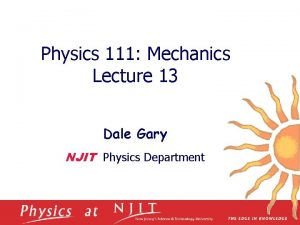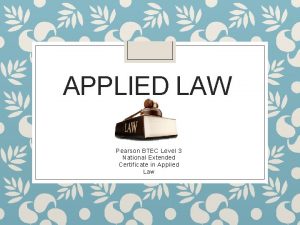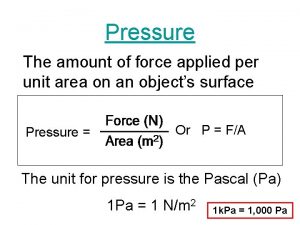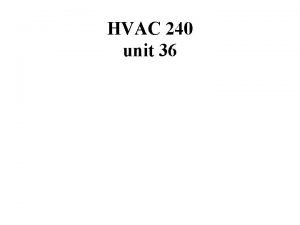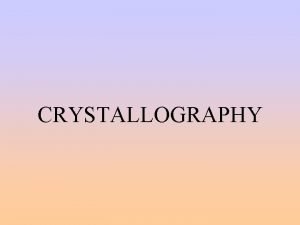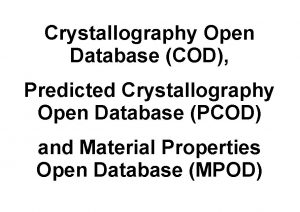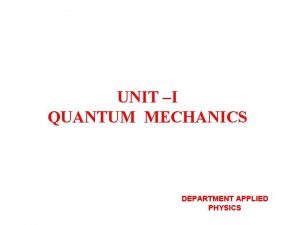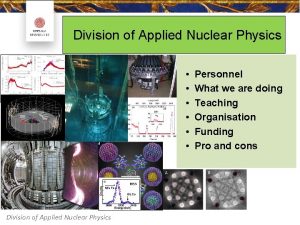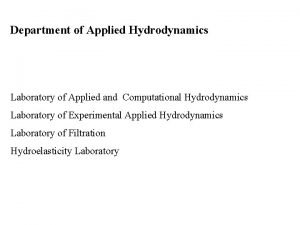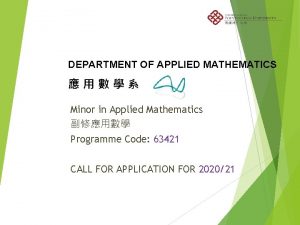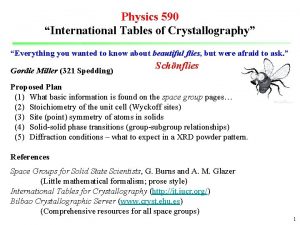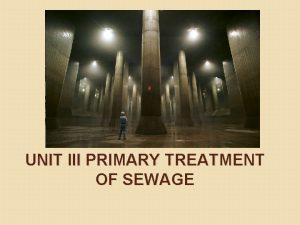UNIT III CRYSTALLOGRAPHY DEPARTMENT OF APPLIED PHYSICS Crystallography



















![6. Voids Space Void Space = [1 - APF] x 100 Simple Cubic Cell 6. Voids Space Void Space = [1 - APF] x 100 Simple Cubic Cell](https://slidetodoc.com/presentation_image_h/2447e7aafb38866ee3bc1c8b8dd0927b/image-20.jpg)











- Slides: 31

UNIT –III CRYSTALLOGRAPHY DEPARTMENT OF APPLIED PHYSICS

Crystallography l. Experimental science of determining the arrangement of atoms in solids and study physical properties of solid. l. Scientific study of crystals.

Crystal Structure (Classification) q. Single Crystals: • Regular periodic arrangement of atoms, • Distinctive shape, • Smooth faces and straight edges, Follows law of constancy of angles. • Possess both short range and long range order. Anisotropic. • Examples: quartz, rocksalt, alum, diamond etc. .

q Polycrystalline Solids: • fine grains (103 -104 Å single crystals of irregular shape), • separated by well defined boundaries and oriented in different directions. • Examples: metals. Isotropic. q Amorphous Solids: l No ordered crystalline state. Short range order in atomic arrangement. Examples: glass, rubber, polymers etc. l l


Space Lattice A Space Lattice is defined as an array of points arranged in a regular periodic fashion in three dimensional space such that each point in the lattice has exactly identical surroundings. It is a skeleton upon which crystal structure is built by placing atoms on or near the lattice points (14 possibilities). Lattice points Lattice lines Lattice Plane

Net : Two dimensional lattice is called net. Translation: l = pa+qb+rc, a, b, c: translational/basis/primitive vectors

Crystal Structure (Crystal Lattice) + = Basis Lattice Sites Crystal Structure • A atom or group of atoms identical in composition, arrangement and orientations is called basis.

Crystal Structure (Unit Cell) • Fundamental block • The unit cell is the smallest geometrical unit , which when repeated in space indefinitely generates the space lattice. • Can be chosen in a number of ways • Is the smallest volume that carries a full description of the entire lattice • Primitive Unit Cell Unit cell is said to be primitive when the cell has lattice points only at its corner. • Non-primitive Unit Cell Non –primitive Unit cell may have the lattice points at the corner as well as at the other locations both inside and on the surface of the cell.

Unit cell • Crystallographic axes : These are the lines drawn parallel to to the lines of intersection of any three faces of the unit cell , which do not lie in the same plane • Lattice constants/Primitives (a, b. c) : The three sides of unit cell are called Lattice constants. • Interfacial angles( α, , ) : The angles between the crystallographic axes of the unit cell are called interfacial angles. • Lattice Parameters : The axial lengths a, b, c, and the three interfacial angles α, , are called as Lattice parameters.

Crystal Systems

Cubic Lattice : The lattice for which the unit cell is a cube , is called a cubic lattice. Simple Cubic (SC) Body Centered cubic (BCC) Face Centered cubic (FCC)

The Unit Cell Characteristics • Unit Cell Volume, V V = abc(1 -cos 2 +2 cos cos ) • • • Effective Number of Atoms per Unit Cell, Z Atomic Radius r Nearest Neighbour distance 2 r Coordination Number, CN Atomic Packing Fraction, APF – APF = Zv / V • Void Space – Void Space = (1 - APF) x 100 • Density = ZM / NAV

CHARACTERISTICS OF UNIT CELLS 1. Unit Cell Volume, V V = a b c (1 -cos 2 +2 cos cos )1/2 For Cubic unit cell a=b= c= & = = =90 hence V = a 3 for SC, BCC & FCC unit cell

2. Effective Number of Atoms per Unit Cell, Z Simple Cubic Cell (SC) Z = 1/8 x 8 ( corners/cell) Z = 1 atom/unit cell Body centered Cubic (BCC) Face Centered Cubic (FCC) Z = 1(body centre atom/unit cell) +1/8 x 8( corners/cell) Z = 2 atoms/unit cell Z = ½ (atom/face) x 6(faces/unit cell) +1/8 x 8( corners/cell) Z = 4 atoms/unit cell

3. Atomic radius , r Simple Cubic Cell (SC) 2 r = a/2 Body centered Cubic (BCC) Face Centered Cubic (FCC) Body diagonal AG = 4 r AG 2 = AC 2 + CG 2 = (AB 2 + BC 2) + CG 2 (4 r)2 = a 2 + a 2 (4 r)2 = 3 a 2 r =( 3/4) a Face diagonal AG = 4 r AC 2 = AB 2 + BC 2 (4 r)2 = a 2 + a 2 (4 r)2 = 2 a 2 r =( 2/4) a = a / (2 2)

4. Nearest neighbour distance, 2 r Simple Cubic Cell (SC) r = a/2 2 r = a Body centered Cubic (BCC) Face Centered Cubic (FCC) r =( 3/4) a 2 r = ( 3/2) a r = a / (2 2 ) 2 r = a/ 2

5. Coordination Number, CN Simple Cubic Cell (SC) CN = 6 Body centered Cubic (BCC) Face Centered Cubic (FCC) CN = 8 CN = 12

6. Atomic Packing Fraction Simple Cubic Cell (SC) Body centered Cubic (BCC) Face Centered Cubic (FCC) APF = (Z )/V APF = (Z ) /V For SC cell, Z = 1 For BCC cell, Z = 2 For FCC cell, Z = 4 u=volume of spherical atom u = 4/3 r 3 u= 4/3 r 3 V = volume of the unit cell = a 3 = (2 r)3 = 8 r 3 = a 3 = (4 r/ 3)3 = 64 r 3 /3 3 V = volume of the unit cell = a 3 = (2 2 r)3 APF = [1 x (4/3 r 3)] / (8 r 3) APF = [2 x (4/3 r 3)] / [64 r 3/ 3 3] APF = [4 x (4/3 r 3)] / [16 2 r 3] APF = /6 = 0. 52 APF = 3 /8 = 0. 68 APF = /3 2 = 0. 74
![6 Voids Space Void Space 1 APF x 100 Simple Cubic Cell 6. Voids Space Void Space = [1 - APF] x 100 Simple Cubic Cell](https://slidetodoc.com/presentation_image_h/2447e7aafb38866ee3bc1c8b8dd0927b/image-20.jpg)
6. Voids Space Void Space = [1 - APF] x 100 Simple Cubic Cell (SC) Body centered Cubic (BCC) Face Centered Cubic (FCC) Void Space = [1 -0. 52] x 100 Void Space = [1 -0. 68] x 100 Void Space = [1 -0. 74] x 100 = 32% = 26% = 48%

7. Density = Mass/Volume = ZW/V ; where W = mass of each atom given by M/NA where M is molecular weight of the material and NA is Avogrado number Hence = ZM/(VNA) Simple Cubic Cell (SC) Body centered Cubic (BCC) Face Centered Cubic (FCC) = ZM/VNA for SC, Z = 1 for BCC, Z = 2 For FCC, Z = 4 Hence, = 1 M/(NAa 3) Hence, = 2 M/(NAa 3) Hence, = 4 M/(NAa 3)

Voids • The vacant space between the atoms in the crystal are called voids or interstices • Three dimensional arrangement of spheres gives rise to voids between their curved surfaces • Mainly two kinds of voids in a close packed structure –Tetrahedral –Octahedral

Tetrahedral Void • Produced by a sphere fitting into the valley formed between three adjacent spheres of a closed pack structure. • If centers of four atoms are joined, a regular tetrahedron is produced • The vacant site enclosed by the tetrahedron is called tetrahedral void • If fourth sphere belongs to upper layer- upright tetrahedral void, else, inverted. .

Octahedral Void • Produced when a void formed by three adjacent spheres in one layer comes on the top of the void formed by three spheres in contact in the adjacent layer • Surrounded by six spheres • The centers of the three spheres in a layer comes exactly on the top of the triangular peripheral valleys formed by the spheres in the bottom layer • Octahedron is obtained on joining centers of six spheres, hence space enclosed is called octahedral void

Tetrahedral Two voids per sphere Surrounded by four atoms Smaller in size and greater in number Octahedral One void per sphere Surrounded by six atoms Bigger in size and smaller in number

Miller Indices are the reciprocals of the intercepts made by the plane on the crystallographic axes, when reduced to smallest integers. Procedure for finding the Miller Indices • Identify the intercepts of planes along three crystallographic axes (The coordinates of the points of interception are expressed as integral multiples of the axial lengths in the respective directions) • Determine the reciprocals of the integers • Reduce the reciprocals to the smallest set of integers h, k, l by taking LCM • (h k l) represent Miller Indices

Miller Indices z A G E Plane intercepts 1 ∞ B y reciprocals O F D x C ABCD Miller Indices BEFC ABEG ∞ ∞ 1∞ ∞∞ 1 100 (1 0 0) 010 001 (0 1 0) (0 0 1)

Family of Symmetry Related Planes ( 1 1 0 ) Z ( 1 0 1 ) ( 0 1 1 ) Y ( 1 1 1 ) X ( 2 2 1 )

Interplanar Distance in the Cubic Crystal • Let dhkl represent the distance between two adjacent parallel planes having Miller Indices (hkl) • Let ABC be one of the planes • Perpendicular OD from the origin to the plane = dhkl • Direction cosines of OD: cosα, cos D α OA = a/h OB = a/k OC = a/l O Cosα = OD/OA = hd/a Cos = OD/OB = kd/b Cos = OD/OC = ld/c

Braggs law of X ray diffraction Path difference is Δ =GE + EH For constructive interference Δ =GE + EH = mλ d. sinӨ+d. sinӨ=mλ 2 d. sinӨ =m λ Which is Bragg’s Law

THANK YOU
 Face centered cubic coordination number
Face centered cubic coordination number Crystallography engineering physics
Crystallography engineering physics Hamlet act iii scene ii
Hamlet act iii scene ii Applied physics yale
Applied physics yale Applied physics letters
Applied physics letters Maritime applied physics corporation
Maritime applied physics corporation Jhu apl internship
Jhu apl internship International union of pure and applied physics
International union of pure and applied physics Dna x-ray crystallography
Dna x-ray crystallography Motif crystallography
Motif crystallography Spherical projection in crystallography
Spherical projection in crystallography Crystallography types
Crystallography types Crystalline solid and amorphous solid
Crystalline solid and amorphous solid Jana 2006
Jana 2006 Crystallography
Crystallography Crystallography
Crystallography Crystallographic information file
Crystallographic information file Xdswiki
Xdswiki X-ray crystallography
X-ray crystallography Cod crystallography
Cod crystallography Princeton
Princeton Physics 121 njit
Physics 121 njit Sputonik v
Sputonik v Warwick physics department
Warwick physics department Bhu physics department
Bhu physics department Iit kanpur physics faculty
Iit kanpur physics faculty Kepler njit
Kepler njit Michigan state university astronomy
Michigan state university astronomy Btec applied science level 3 unit 2
Btec applied science level 3 unit 2 Applied law unit 3 past papers
Applied law unit 3 past papers A water glass sitting on a table weighs 4n
A water glass sitting on a table weighs 4n Unit 36 refrigeration applied to air conditioning
Unit 36 refrigeration applied to air conditioning
